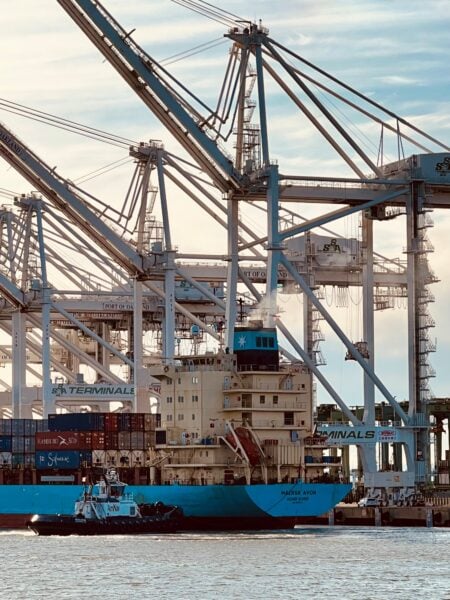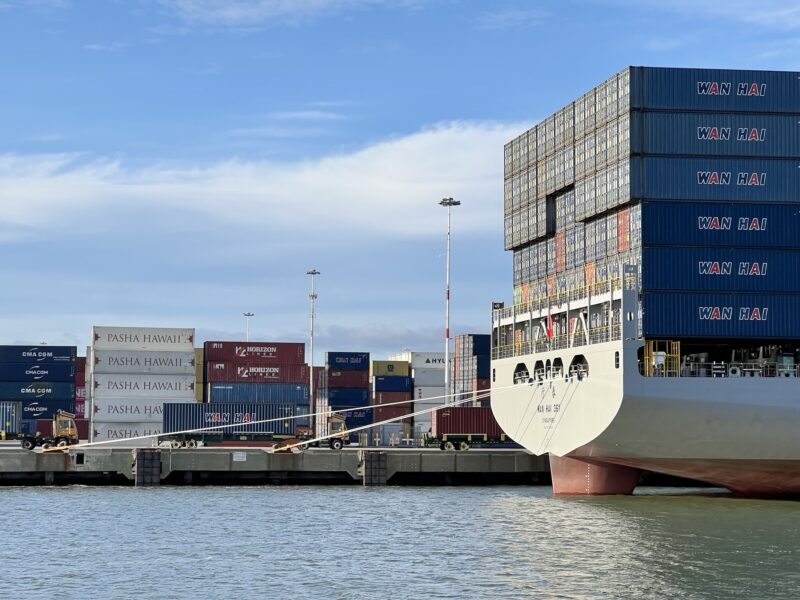Air pollution from ports comes from many sources: ships, trains, tugboats, cargo equipment, and – quite importantly – the trucks that move cargo containers to and from ports. The vehicles, vessels, and equipment that move our freight create hot spots of some of the worst air quality in the country and contribute significantly to climate change. However, zero-emission options for these workhorses of the economy are growing rapidly and some ports are beginning to move towards cleaner operations.
To accelerate the much-needed transition to cleaner ports nationwide, the Environmental Protection Agency (EPA) announced the Clean Ports Program (CPP), which provides $3 billion for zero-emission equipment and climate and air quality planning at our country’s ports. This funding, provided by the Inflation Reduction Act, is available to a wide variety of entities, including port authorities, local and tribal governments, and regional air quality agencies as well as businesses and non-profits that partner or collaborate with these public entities.
The types of projects eligible under the CPP range widely, but notably the agency is focused on already proven zero-emission technologies, like electric tractor trucks, tugboats, and cargo handling equipment. Additionally, much-needed activities like localized air quality monitoring, enhanced port collaboration with communities, and planning for things like climate resiliency and future zero-emission projects are eligible for funding. The program is squarely focused on zero-emission equipment and projects – combustion technologies are explicitly ineligible.
In addition to focusing on currently available technology, CPP is focused on projects that can begin near-term. The funding process for awarded projects is on a quick timeline, set to be released in late 2024. The amount of funding for zero-emission equipment ranges by port size and type. The largest water ports (think Ports of LA/Long Beach, Port of Houston, and the like) are eligible for between $150 million and $500 million per grant with a minimum cost share of 20 percent. Smaller water ports and inland ports (think intermodal rail yards and similar facilities) are eligible for up to $150 million with a 10 percent cost share, and both dry and inland ports run by Tribal governments are eligible for up to $50 million per grant, 100 percent funded by the program.
Combined with the new incentives to electrify commercial vehicles in the Inflation Reduction Act, and the billions of dollars in climate and air quality funding available from other federal programs like the Climate Pollution Reduction Grant, the CPP represents a meaningful step towards reducing climate-warming and toxic air pollution from our freight system.
The flexibility of the program will likely mean that a diverse array of project types will be funded under the CPP. I thought it would be helpful to highlight some potential projects that could be awarded under the program as food for thought. Here are a few examples (in no particular order).

Electrifying tugboats
Harbor craft are a significant source of air pollution at ports, responsible for sizable portions of air and climate pollutants at seaports. Zero-emission tugboats may not be in the spotlight as much as electric cars and trucks, but these cleaner, quieter, and capable powerhouses are beginning to hit the water. While their abilities have been well-proven, electric tugboats are still a novelty; CPP funding could help to raise the profile of these vessels and drive costs down as more are ordered, in addition to the obvious air quality benefits.

Accelerated transition to clean drayage trucks
Drayage trucks – tractor trucks that move shipping containers to and from ports – are among the dirtiest of the dirtiest vehicles on our roads and contribute significantly to air pollution in areas near ports. Because drayage trucks tend to be among the oldest tractor trucks on the road, they tend to pollute at greater rates than other tractors. Mile for mile, a typical drayage truck operating out of the Port of LA emits around 70 percent more ozone-forming nitrogen oxides and over 20 percent more lung-damaging fine particulate matter compared to the typical tractor truck in the rest of California, according to CARB.
While drayage trucks and their charging stations are beginning to come online across California, progress has been much slower in the rest of the country. The CPP could support a variety of projects to electrify drayage operations, including the purchase of trucks, constructing charging stations to support funded trucks, and even onsite renewable energy generation and minor grid upgrades. Although drayage fleets themselves aren’t eligible for the funding, ports and municipalities could partner directly with local drayage fleets or use the funding to prop up a program to help independent drayage operators purchase zero-emission trucks. Coupled with the up-to-$40,000 per truck federal incentive, funding for drayage electrification from CPP could help boost the market for clean drayage trucks.

Electrifying off-road cargo handling equipment
In addition to the drayage trucks that move containers on roads and highways, ports are home to yard trucks and polluting cargo equipment that move and organize shipping containers around the facility. Zero-emission yard trucks have already been deployed at ports and freight facilities across the country with great success. Orange EV, an electric yard tractor manufacturer based in Kansas City, has deployed its battery-powered trucks across the country for nearly a decade. Other electric “off-road” cargo equipment like the massive cranes and forklifts that move and stack containers could be eligible for funding under the program.

Better quality community-level data
Community and non-profit organizations can also apply for funding under the CPP, so long as they partner with an eligible public entity. The CPP could fund various types of projects to gather data on air quality and pollution sources, such as hyperlocal air quality monitors or visual truck counting technologies. These projects could be conducted by a community group in partnership with a local government, air quality management district, or port authority. A local air quality monitoring project like this is planned this year in the port-adjacent neighborhood of West Oakland and an innovative truck counting project, called Chicago Truck Count Data Portal, recently published.
High-quality localized air quality monitoring combined with truck count data could help to provide a better understanding of how individual communities are impacted by air pollution from ports and other sources. Because national air quality standards are enforced using ambient air quality measurements over large areas and timescales (daily and annual averages), they may not always accurately account for shorter spikes in air pollution or high concentrations in specific areas. Neighborhoods adjacent to ports often have significant levels of drayage truck traffic, which can cause these localized pollution spikes. Higher quality data in these areas could help to empower communities and mobilize decisionmakers to address this issue of environmental equity.

Funding for ports to improve collaboration with impacted communities
In addition to the projects and planning activities CPP can support, it can also provide funding to ports to increase its engagement efforts with communities. This could cover a range of things from propping up new collaborative programs internally to supporting staff and administration costs for consulting with community leaders. Regular and meaningful engagement among port authorities and port-adjacent communities is an important step toward addressing the historical and disproportionate impacts of port pollution. Also notable is that EPA signaled that they will prioritize applicants who have previously and will continue engaging with disproportionately impacted communities over the long term.
More work to be done…
These potential projects are but a few examples of the meaningful and urgent work needed to reduce pollution from ports across the country. While this program represents a significant and targeted investment by the federal government to address climate-warming and toxic air pollution from ports, it is but one of many state and federal actions needed to mitigate climate change and address air quality disparities.

